Yogyakarta, Java, Indonesia
We left the island of Bali and
flew to the island of Java and to the city of Yogyakarta---say jog (long o) ja
karta or just Jogja.
Prambanan
Temple is
Hindu and was erected in the 10th century. It consisted of three main temples
surrounded by many smaller ones. When first rediscovered in the 1700s, it was
only about one-fourth of its original height but archeologists have
reconstructed much of it using the original materials. An earthquake in 2006
did some damage and work is still progressing. We entered one small temple to
see the statue of a bull and made several photos around the exteriors of other
structures. As the temples are empty and/or not stabilized, we declined to
enter others. After leaving that temple area, we took a tram through the park
passing another temple so damaged that reconstruction is impossible. We made a
photo stop at Sewu Temple, a Buddhist
temple whose names means one thousand. Legend says that an Indonesian princess
told a suitor she would marry him if he could erect one thousand temples in one
day; he failed even with supernatural help because she tricked him and he
cursed her by calling her "the one thousandth temple."
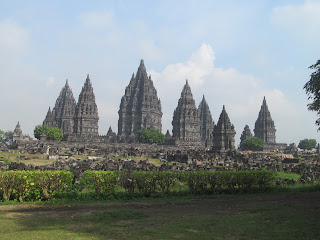












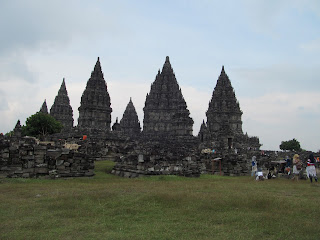
Sultan's
Palace. This
is the ceremonial residence of the Sultan, the 10th of the dynasty; he has no
son to succeed him. Typical Indonesian architecture consisting of a series of
pavilions arranged within a compound made the palace interesting. In
Yogyakarta, the Sultan serves as governor and the position is hereditary and
not elective.
The
Water Palace erected
in the 1700s consists of a series of swimming pools. A pool on one end served
for the Sultan's daughters while a larger pool in the center was for Sultan's
wives. An apartment with a viewing post for the Sultan stood at the end of that
pool. When the Sultan chose the wife he wanted for that particular time, she
and he used a private pool on the other side of the apartment. [Some young
women were washing their faces in this pool because legend says those who do
"will be forever young.] There was also a bed in the Sultan’s apartment.




It was 3:51 a.m. as we drove
out of the hotel grounds and pitch black. We arrived on the grounds of Borobudur Temple before five o'clock. It
didn't take long for us to be outfitted with sarongs and small flashlights. We
waited a few minutes before beginning the walk along the paved pathway through
the dimly lighted grounds. The leisurely walk brought us to the base of the
temple, rising like a stone mountain in the dark; as we turned and looked
toward the East, we could see dim outlines of two volcanoes on the horizon. The
9th century temple was restored by the Dutch in the early 1900s and UNESCO in the
1980s. It is divided vertically into three parts: Hell; Earth; Heaven. Hell, or
the lustful life, is the bottom portion but the carvings on it are totally
encased in a seven-meter-thick wall which serves as a buttress to brace the
temple. Restorers think early builders thought the structure too vertical to be
stable and added it soon after construction was completed. We began our climb
up a tall and steep stairway. The first level was fairly easy because the steps
had a regular tread and a short rise. The second portion was more difficult as
the staircase narrowed and the rise of the steps was taller. The third portion
was even narrower with a tall rise, but this portion had handrails. It was
about 5:40 when we reached the top level and took our seats to await the sunrise.
Watching the gradual lighting of the sky provided a calming experience. When
the sun finally rose between the two volcanoes, it flooded the valley below
with light. We enjoyed the experience and the fact that the temple wasn't
overcrowded. After sunrise, we walked around the top level while our guide explained
the structures and their restoration. The same happened on each of the two
other levels. The double frieze on the middle level tells Buddha's life. Only a
few panels on the southeastern corner of the bottom level are uncovered for
viewing; the others are under the buttressing wall for protection.

.JPG)
.JPG)
.JPG)
.JPG)
.JPG)
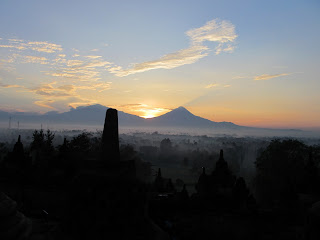.JPG)
.JPG)
.JPG)
.JPG)
.JPG)
.JPG)
.JPG)
.JPG)
.JPG)
A mortise and tenon joint in stone.
Model of Borobudur Temple
Candirejo Village is an insight into
Javanese village life. We took a horsedrawn cart through the village, stopping
first at the village hall, a three-hundred-year-old pavilion with a packed
earthen floor. We saw some examples of crops: papaya; chili; pepper; corn;
guava; cassava; peanuts. At a farm, we saw how the farmer had a catfish pond;
cow and calf; two goats; some chickens. We did a trek down an overgrown pathway
to the confluence of three rivers before getting back on the cart
We stopped to learn how they
grow mushrooms in containers.
Passing Mendut Temple, a small structure, we stopped at Pawon Temple to see the 3 statues of Buddha
inside; one shows him seated as if on a throne.
In the distance, we could see Merapi Volcano and began the drive
toward it. We learned that the lava usually flows down the riverbeds and that
the last eruption left some 3+ centimeters of ash. We began to see the damage
along the roadside. Once at the final driving point, we got out and looked at
the explanations of how the volcano erupted in 2006 and 2009 and of the damage
and loss of life.





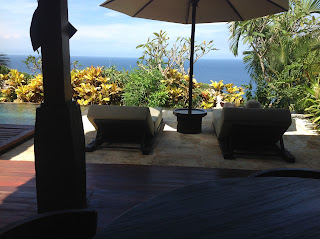
























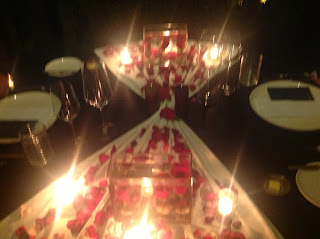






























.JPG)
.JPG)
.JPG)
.JPG)
.JPG)
.JPG)
.JPG)
.JPG)
.JPG)
.JPG)
.JPG)
.JPG)
.JPG)
.JPG)
.JPG)

.JPG)
.JPG)
.JPG)
.JPG)
.JPG)
.JPG)
.JPG)
.JPG)
.JPG)
.JPG)
.JPG)
.JPG)
.JPG)
.JPG)
.JPG)
.JPG)
.JPG)
.JPG)
.JPG)
.JPG)
.JPG)
.JPG)
.JPG)
.JPG)
.JPG)
.JPG)
.JPG)
.JPG)